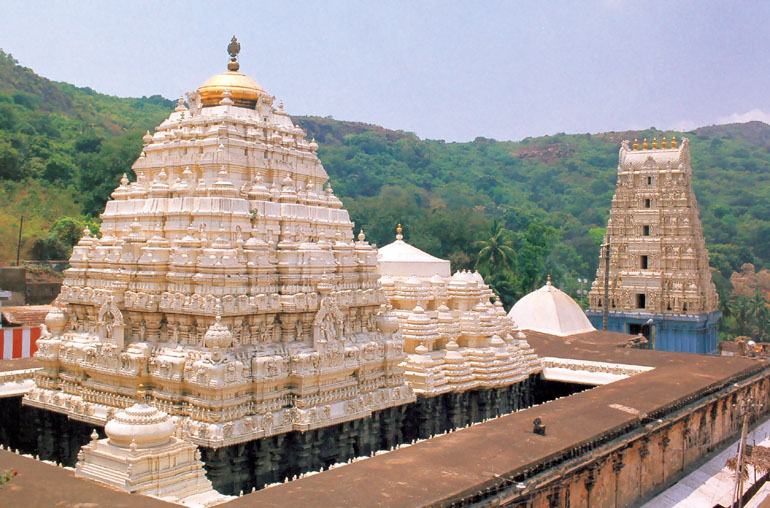"Simha" means lion; "Adri" or "Achala" means hill. The temple is located at the top of a hill; hence the temple is called Simhachalam. Sri Varahalakshmi  Narasimha Swamy, the lion-man incarnation of Lord Vishnu, is the presiding deity of the temple. The temple is one of the eighteen "Narasimha Kshetras", the shrines of Lord Narasimha, in India. The deity is usually covered with sandalwood paste year round and can be seen without sandalwood ("nijaroopa darshan" – holy appearance in true form) for only 12 hours per year. On Akshaya Tritiya Day, the deity is re-covered with sandalwood paste. The festival of 'Chandana yatra' or 'Chandanotsavam' falls every year in Vaisakha (May).
Narasimha Swamy, the lion-man incarnation of Lord Vishnu, is the presiding deity of the temple. The temple is one of the eighteen "Narasimha Kshetras", the shrines of Lord Narasimha, in India. The deity is usually covered with sandalwood paste year round and can be seen without sandalwood ("nijaroopa darshan" – holy appearance in true form) for only 12 hours per year. On Akshaya Tritiya Day, the deity is re-covered with sandalwood paste. The festival of 'Chandana yatra' or 'Chandanotsavam' falls every year in Vaisakha (May).
The deity is in the tribhangi posture, with two hands and the head of a lion on a human torso. An inscription dated 1098 AD of the Chola King Kuloththunga provides a clue as to its antiquity. Another inscription names a queen of the Eastern Ganga of Kalinga (ancient Odisha) (1137–1156), while a third inscription says the eastern Ganga King of Odisha, Narasimhadeva II (1279–1306), built the central shrine in 1267. More than 252 inscriptions in Odia and Telugu describe the antecedents of the temple.
Sri Krishna Deva Raya visited the shrine in 1516 and 1519. He offered numerous valuable jewellery, of which an emerald necklace is still in the temple. For the last three centuries the royal family of Vizianagaram, the Pusapati Gajapathis, have been the temple's trustees.The last King of Vizianagaram Dr.PVG Raju Garu donated Lakhs of acres of land to Simhachalam Devastanam.
Geography
The Simhachalam temple faces west. According to religious belief, an east-facing entrance brings prosperity, while a west-facing one brings victory. The temple is situated among hills covered with cashew trees, shrubs, and mango groves. Many pilgrims undertake Giripradhikshana (circumambulation) of the hill on auspicious days. Neighbourhoods near the pilgrimage include Srinivasanagar, Prahladapuram, Sainagar colony, Simhapuri colony, and Simhapuri Layout. The journey often extends into the night, as the route is around 40 kilometres (25 mi). Pilgrims then visit the temple to give offerings to the deity.